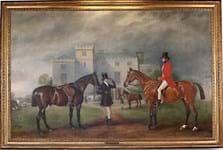
A 16th century tin-glazed earthenware charger with geometric pattern and inscription, £39,000 at Toovey’s.
The 8¼in (21cm) diameter blue and white dish is dated 1567, putting it among the earliest known examples of northern European tin-glazed earthenware.
Estimated at £200-300 at Toovey’s in Washington, West Sussex, it was hammered down at £39,000 on October 26 (plus 29.4% buyer’s premium inc VAT).
Decorated with geometric patterns, it contains an inscription in Dutch roughly translating as “those who do not work do not eat…” (attributed to St Paul in the New Testament).
The dish was consigned by a private collector, local to Toovey’s, who often sells through the auction house. He had bought the dish around 20 years ago at another local auction, probably as part of a job lot.
Tom Rowsell, director at Toovey’s, said: “We thought it would do quite well but not quite as well as it did. We agreed the ‘come and get me’ estimate with the vendor so he was ecstatic with the result. We had three phone bidders - one in London and two Dutch bidders.” The buyer was one of the bidders in the Netherlands, new to the auction house.
Unusual inscription
Among the bidders was Kensington ceramics specialist E&H Manners. Henry Manners said: “It is a fascinating little thing and one of the earliest dated Netherlandish examples. It is really unusual to have an inscription like this.”
Although pieces dating to the mid-1550s are known, examples of this age are usually either drug jars, with a description of what it contains, or decorative tiles. Manners believes it could be from Antwerp (then part of the Netherlands).
Antwerp had undergone a huge expansion in the 1500s and had a monopoly over the production of this type of earthenware (influenced by southern Europe’s maiolica and faience) in the region.
However, around the time the dish was made the city was losing its trading importance because of numerous religious, political and economic upheavals, including the Reformation riots, the Dutch revolt and the Eighty Years War.
Its Protestant potters then began to move north and by the late 16th century production of northern European maiolica had moved away from Antwerp.
















